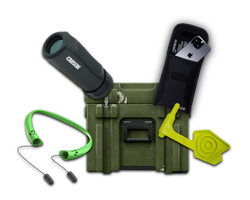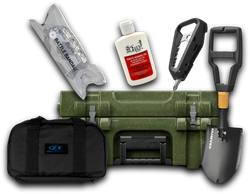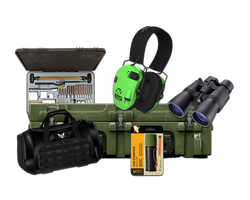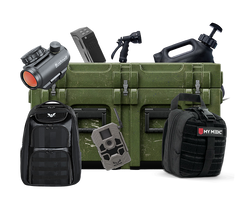How to Make Shooting Targets: A Comprehensive Guide for Tactical Enthusiasts
Table of Contents
- Introduction
- The Importance of Shooting Targets in Training
- Types of Shooting Targets You Can Create
- How to Make Shooting Targets: Step-by-Step Instructions
- Tips for Using Your Targets Effectively
- Crate Club: Your Partner in Tactical Training
- Conclusion
- FAQ
Introduction
Imagine standing at a shooting range, the scent of gunpowder in the air, the sound of bullets hitting targets resonating around you. Now, picture yourself ready to take aim, but you realize you have no targets to shoot at. This scenario can quickly turn your shooting session from exhilarating to disappointing. Fortunately, making your own shooting targets is not only a practical solution but also an engaging DIY project that can enhance your skills and save you money.
In this guide, we will delve into the various methods of creating shooting targets, focusing on their importance in training, cost-effectiveness, and the types of materials you can use. Whether you're a novice shooter or an experienced marksman, understanding how to make effective shooting targets can significantly improve your shooting practice and help you track your progress.
This article will cover an array of topics, including:
- The importance of shooting targets in training.
- Different types of shooting targets you can create.
- Step-by-step instructions for making various DIY targets.
- Tips on using your targets effectively.
- How Crate Club's subscription service can support your tactical training journey.
By the end of this guide, you will not only learn how to make shooting targets but also gain insights into how to optimize your shooting practice with the right tools and techniques. Let’s get started!
The Importance of Shooting Targets in Training
Shooting targets serve a critical role in firearms training. They provide a focal point for shooters, allowing them to practice precision, accuracy, and control. Here are a few reasons why shooting targets are essential:
Enhancing Skill Development
Targets help shooters develop their skills in various areas, including:
- Aiming: Targets provide a visual cue for shooters to align their sights accurately.
- Trigger Control: Practicing with targets allows shooters to focus on their trigger squeeze without the distraction of other elements.
- Distance Estimation: Different types of targets can be placed at various distances, helping shooters learn range estimation and adjust their aim accordingly.
Measuring Progress
Using targets also enables shooters to track their improvement over time. By keeping records of their hits and misses, they can identify areas that need more attention. For example, if a shooter consistently misses a particular zone on the target, they can adjust their technique accordingly.
Budget-Friendly Practice
Buying pre-made targets can become costly, especially for frequent shooters. By learning how to make your own shooting targets, you can save money while enjoying the process of crafting personalized training aids.
Types of Shooting Targets You Can Create
Before diving into the specifics of how to make shooting targets, it’s essential to understand the different types available. Depending on your goals and preferences, you can create various targets:
Paper Targets
Paper targets are among the simplest and most cost-effective options. They can be printed or drawn and are ideal for indoor and outdoor ranges. Common designs include:
- Bullseye Targets: Simple concentric circles that help shooters focus on accuracy.
- Silhouette Targets: Representing human figures, they are great for tactical training.
- Score Targets: Featuring scoring zones, these targets are excellent for competitive shooting practice.
Cardboard Targets
Cardboard is a versatile material for creating DIY targets. It is readily available and can be transformed into various shapes. You can create:
- USPSA Targets: By cutting cardboard into the standard dimensions of USPSA targets, you can practice competitive shooting.
- Custom Shapes: Cardboard allows for creativity, enabling you to design unique targets for specific practice scenarios.
Steel Targets
While slightly more advanced, steel targets offer a rewarding shooting experience. They are durable and provide instant feedback with a satisfying sound upon impact. You can make:
- Reactive Targets: Steel plates that move or fall upon being hit.
- Fixed Targets: Steel silhouettes that remain stationary for shooting practice.
DIY Shoot-and-See Targets
These targets provide visual feedback on your hits, typically using bright colors that show where you’ve shot. They’re perfect for developing shooting accuracy and can be made using simple materials.
How to Make Shooting Targets: Step-by-Step Instructions
Now that you understand the different types of shooting targets, let’s dive into step-by-step instructions for creating some of the most popular DIY targets.
1. Making Paper Bullseye Targets
Creating paper bullseye targets is quick and straightforward. Here’s how to do it:
Materials Needed
- Printer or plain paper
- Compass or round object for tracing
- Marker
- Ruler (optional)
Instructions
-
Draw the Target: Use a compass or a round object to trace concentric circles on the paper. The innermost circle should be the smallest, representing the bullseye. Each subsequent circle should be larger than the last.
-
Label Scoring Zones: Assign point values to each circle, starting with the bullseye at 10 points and decreasing as you move outward.
-
Print or Copy: If using a printer, design your target using software or online templates, then print multiple copies.
-
Cut and Hang: Cut the paper into desired sizes and hang them securely at your shooting range.
2. Creating Cardboard USPSA Targets
If you’re interested in competitive shooting, making USPSA targets is a great project.
Materials Needed
- Cardboard box (medium-sized)
- Box cutter
- Tape measure
- Ruler or straight edge
- Pencil or marker
Instructions
-
Cut the Box: Open the cardboard box and cut it in half along the fold line, leaving the halves attached.
-
Measure Dimensions: Use the ruler to measure out the standard USPSA target dimensions (18 inches wide by 30 inches tall). Mark the outline with a pencil.
-
Cut Out the Target: Using the box cutter, cut along the outline to create your target. You can also cut out scoring zones if desired.
-
Create Templates: Use the first target you made as a template for creating additional targets. Simply trace around it and cut as needed.
3. Building Steel Targets
For those looking to invest time and resources, steel targets can be incredibly rewarding.
Materials Needed
- Steel plates (1/4 inch thick recommended)
- Welding or bolting materials (if necessary)
- Target stands (can be made from wood or purchased)
- Paint (for visibility)
Instructions
-
Cut Steel Plates: If you have access to a plasma cutter or metal saw, cut the steel plates into your desired shapes (e.g., square, circle, silhouette).
-
Create Stands: Construct stands using wood or metal to securely hold your steel plates. Ensure they are stable enough to withstand impacts.
-
Paint the Targets: For visibility, paint the targets in bright colors or use reflective paint.
-
Set Up: Position the targets at your shooting range, ensuring they are at a safe distance for shooting.
4. DIY Shoot-and-See Targets
Making your own shoot-and-see targets is an excellent way to visually track your performance.
Materials Needed
- Poster board or thick paper
- Fluorescent stickers or paints
- Black marker
Instructions
-
Create a Base: Use the poster board as a base for your target.
-
Add Fluorescent Dots: Place fluorescent stickers on the board to represent the target zones, or use paint to create bright spots.
-
Outline with Marker: Use a black marker to outline the target areas, enhancing visibility.
-
Hang and Shoot: Hang your targets at your range and observe the spots where you hit during practice.
Tips for Using Your Targets Effectively
Creating targets is just one part of your shooting practice. Here are some tips to maximize their effectiveness:
- Vary Your Distance: Place targets at different distances to simulate various shooting scenarios. This will help improve your range estimation skills.
- Track Your Progress: Keep a log of your shooting sessions, noting the number of hits, misses, and any adjustments made to your technique.
- Incorporate Different Scenarios: Use silhouette targets for tactical training and practice engaging multiple targets in quick succession.
- Engage with the Community: Share your DIY target creations with fellow enthusiasts. Engaging with the Crate Club community can provide inspiration and new ideas for your shooting practice.
Crate Club: Your Partner in Tactical Training
At Crate Club, we understand the importance of having the right gear for your tactical training. Our subscription service offers a curated selection of high-quality tactical gear and survival tools tailored to your needs. With four tiers of subscriptions, including the Lieutenant, Captain, Major, and General, we ensure you receive the best gear available.
- Lieutenant Tier: Perfect for newcomers, this tier offers survival tools, fire-starters, and EDC gear for just $49.99/month.
- Captain Tier: For those seeking a balanced mix of tactical gear, this tier provides medical kits and outdoor essentials for $99.99/month.
- Major Tier: Designed for experienced survivalists, you'll receive premium gear valued at over $305 for $199.99/month.
- General Tier: This quarterly subscription includes real-issue tactical gear used by professionals, valued at over $561 for $399.99.
With Crate Club, you have access to the best tools and resources to enhance your shooting practice and preparedness. Explore our subscription options and our Shop for additional products that can complement your DIY target-making endeavors at Crate Club Subscription Services and Crate Club Shop.
Conclusion
Learning how to make shooting targets empowers you to take control of your training and enhance your skills while saving money. From simple paper targets to durable steel options, there's a method for everyone, regardless of experience level. By understanding the different types of targets, following step-by-step instructions, and utilizing effective practices, you'll be well on your way to becoming a better marksman.
Remember, the journey to mastering shooting involves continuous practice and improvement. Keep challenging yourself, and don't hesitate to share your experiences with the Crate Club community. Together, we can foster a culture of preparedness and excellence in tactical training.
FAQ
1. Can I use any type of paper for making shooting targets?
Yes, you can use any type of paper, but thicker paper or cardstock is recommended for durability.
2. How do I effectively track my shooting progress?
Keep a shooting log that records the date, target type, distance, hits, misses, and any adjustments to your technique.
3. What is the best distance to set my targets?
Start at a distance that challenges you but allows for accuracy. As you improve, gradually increase the distance to enhance your skills further.
4. Are DIY targets as effective as store-bought ones?
Yes, DIY targets can be just as effective, especially if designed with specific training goals in mind.
5. How often should I change my targets?
Change your targets based on wear and tear, but also consider varying them to keep your practice sessions engaging and challenging.
By following these guidelines and utilizing the resources available through Crate Club, you'll be well-prepared to create effective shooting targets that enhance your training and performance. Happy shooting!
Share this article



